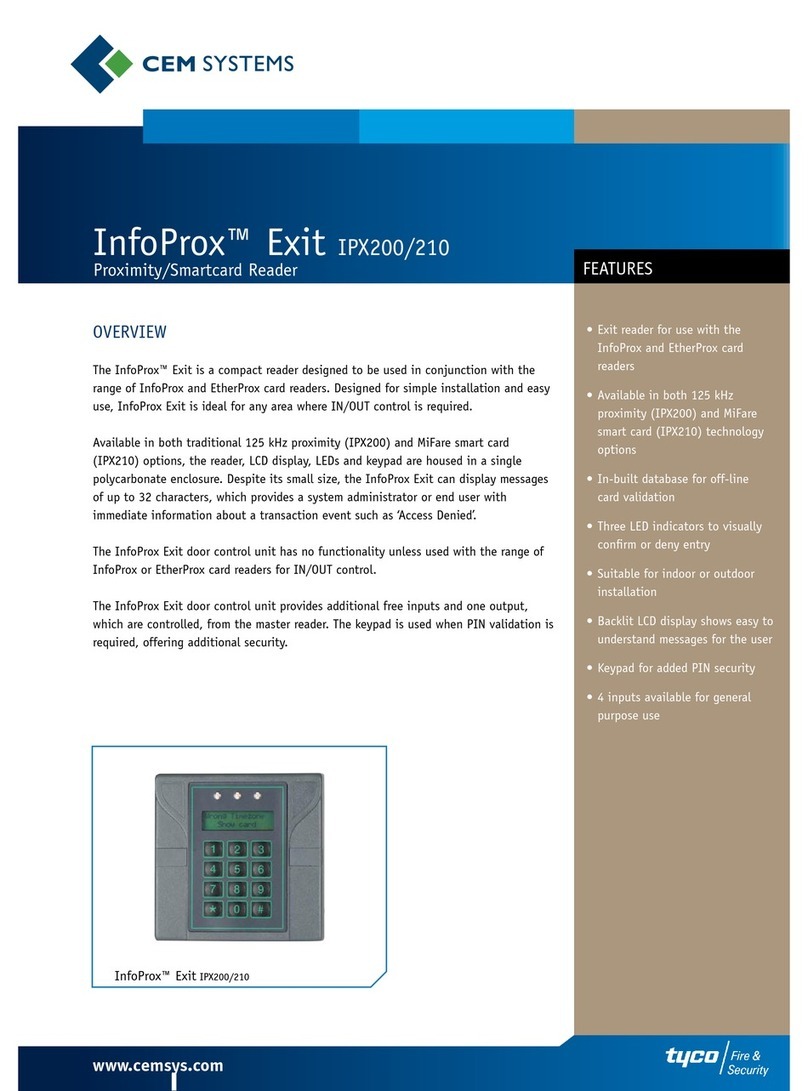
Smart card readers / Lecteurs de cartes à puce
Mounting instructions
To install the reader, complete the following steps:
1. Pull the cable from the wall through the hole of the
mounting plate.
2. Attach the mounting plate to the wall.
3. For tamper detection, cut the plastic tab from the
mounting plate.
4. Fasten the white reflector tab back on the wall.
5. After installing the wiring using the wiring diagrams,
insert the hook at the top of the cover into the
mounting plate tab and press the bottom of the cover
until the bottom hook snaps into place.
6. Use the provided Phillips head screw to secure the
bottom of the reader.
Note: If using CAT5 cable, use two wires for GND, and two wires
for PWR.
Instructions pour montage
Pour installer le lecteur:
1. Tirez le câble du mur et le passer à travers la plaque
de montage.
2. Fixez la plaque de montage au mur.
3. Pour une détection d'anti-sabotage, coupez la languette
en plastique à partir de la plaque de montage.
4. Refixez la languette blanche du réflecteur sur le mur.
5. Après l'installation du câblage conformément aux
schémas de câblage, insérez le crochet en haut du
couvercle dans la languette de la plaque de montage
et appuyez sur le bas du couvercle jusqu'à ce que le
crochet inférieur s'enclenche.
6. Utilisez la vis à tête Phillips pour fixer la partie
inférieure du lecteur.
Note: Si vous utilisez un câble CAT5, utilisez deux fils pour GND et
deux fils pour PWR.
Take note of the
serial number,
you need it
in EntraPass /
Prenez note du
numéro de série,
car vous pourriez
en avoir besoin
dans EntraPass
3
4
FCC COMPLIANCE STATEMENT
CAUTION: Changes or modifications not expressly approved by KANTECH could void your authority to use this equipment.
Thisequipment generates and uses radio frequency energy and if not installed and used properly, in strict accordance with the manufacturer’sinstructions, may cause
interference to radio and television reception. It has been type tested and found to comply with the limitsfor Class B device in accordance with the specifications in Sub-
part “B” of Part 15 of FCC Rules, which are designed to provide reasonable protection against such interference in any residentialinstallation. However, there is no guar-
antee that interference will not occur in a particular installation. If this equipment does cause interference to television or radio reception, which can be determined by
turning the equipment off and on, the user is encouraged to try to correct the interference by one or more of the following measures:
nRe-orient the receiving antenna.
nRelocate the alarm control with respect to the receiver.
nMove the alarm control away from the receiver.
nConnect the alarm control into a different outlet so that alarm control and receiver are on different circuits.
If necessary, the user should consult the dealer or an experienced radio/television technician for additional suggestions. The user may find the following booklet prepared
by the FCC useful: “How to Identify and Resolve Radio/Television Interference Problems”. This booklet isavailable from the U.S. Government Printing Office, Wash-
ington D.C. 20402, Stock # 004-000-00345-4.
INDUSTRY CANADA STATEMENT
CAN-ICES-3(B)/NMB-3(B)
Mullion MT Mullion SC
FCC ID: V8515KTMULMTKPFCC ID: V8515KTMULSCKP
IC: 5690B-KTMULMTKPIC: 5690B-KTMULSCKP
Single Gang MT Single Gang SC
FCC ID:V8515KTSGMTKPFCCID:V8515KTSGSCKP
IC:5690B-KTSGMTKPIC: 5690B-KTSGSCKP
Thisdevice complieswith IndustryCanada licence-exempt RSSstandard(s). Operation issubject to the following two conditions: (1) thisdevice maynot cause inter-
ference, and (2) thisdevice must accept anyinterference, including interference that may cause undesired operation of the device.
Le présent appareilest conforme auxCNR d'Industrie Canada applicablesauxappareilsradio exemptsde licence. L'exploitation est autorisée
auxdeuxconditionssuivantes: (1) l 'appareil ne doit pasproduire de brouillage, et (2) l 'utilisateurde l 'appareil doit acceptertout brouillage radioélectrique subi, même si
le brouillage est susceptible d 'en compromettre le fonctionnement.
Thisdevice complieswith Part 15 ClassBof the FCC rules. Operation issubject to the following two conditions: (1) thisdevice maynot cause harmfulinterference, and
(2) thisdevice must accept anyinterference received including interference that maycause undesired operation. ThisclassBdigitalapparatusmeetsallrequirementsof
the Canadian Interference Causing Equipment RegulationsCANICES-3 (B) / NMB-3 (B).
UL294 Performance Levels and Requirements:
Destructive Attack: LevelI(no attack test)
Line Security: LevelIII via RS-485 communication and EntraPassreader template having Buzzer enabled for Comm failalarm; Level 1 via
Wiegand communication.
Endurance: LevelIV (100,000 cycles)
Standby Power: LevelI(no integralstandbypower)
Installation location and wiring methodsshallbe in accordance with the NationalElectricalCode, ANSI/NFPA 70. There isno maintenance required and there are no
replacement partsrequired for these devices.
For BLE mobile credential installations, BLE v4.2 or higher, Android OS 9.0 or higher, Apple iOS 9 or higher, and EntraPass go Pass 2.00.xxor higher are supported.






















